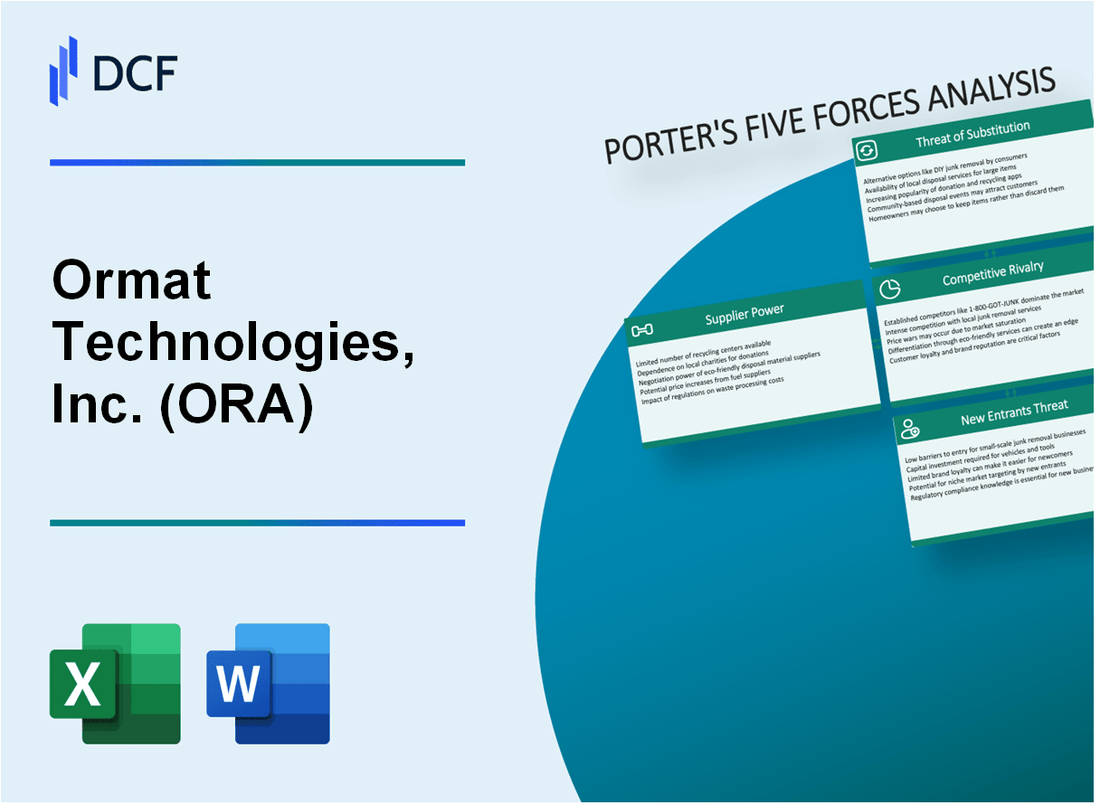
|
Ormat Technologies, Inc. (ORA): 5 Forces Analysis [Jan-2025 Updated] |

Fully Editable: Tailor To Your Needs In Excel Or Sheets
Professional Design: Trusted, Industry-Standard Templates
Investor-Approved Valuation Models
MAC/PC Compatible, Fully Unlocked
No Expertise Is Needed; Easy To Follow
Ormat Technologies, Inc. (ORA) Bundle
In the dynamic landscape of renewable energy, Ormat Technologies, Inc. (ORA) navigates a complex ecosystem of technological innovation, market competition, and strategic challenges. As geothermal energy emerges as a critical player in sustainable power generation, understanding the intricate forces shaping Ormat's business becomes paramount. This deep dive into Michael Porter's Five Forces Framework reveals the strategic pressures, competitive dynamics, and potential opportunities that define Ormat's position in the evolving renewable energy marketplace, offering insights into how the company can leverage its strengths and mitigate potential market risks.
Ormat Technologies, Inc. (ORA) - Porter's Five Forces: Bargaining power of suppliers
Limited Number of Specialized Geothermal Equipment Manufacturers
As of 2024, the global geothermal equipment manufacturing market is characterized by a restricted number of specialized suppliers. Approximately 7-9 primary manufacturers dominate the global geothermal equipment production landscape.
| Manufacturer | Global Market Share | Specialized Equipment Production |
|---|---|---|
| Fuji Electric | 18.5% | Geothermal turbines |
| Toshiba | 15.3% | Power generation systems |
| Mitsubishi Heavy Industries | 14.7% | Geothermal plant components |
High Technological Expertise Requirements
Geothermal power plant component manufacturing demands exceptional technological capabilities. The technical complexity is reflected in the following key areas:
- Advanced materials engineering
- Corrosion-resistant metallurgy
- High-temperature tolerant design
- Precision manufacturing techniques
Capital Investment in Specialized Equipment
The capital requirements for geothermal equipment manufacturing are substantial. Estimated investment ranges for specialized manufacturing facilities are:
| Equipment Type | Estimated Capital Investment | Development Timeframe |
|---|---|---|
| Geothermal Turbine Facility | $75-120 million | 3-4 years |
| Heat Exchanger Production Line | $45-65 million | 2-3 years |
Supply Chain Constraints in Renewable Energy Technology
Supply chain constraints in geothermal technology are evident through several critical factors:
- Raw material availability: Limited rare earth metal sources
- Manufacturing capacity: Global production constraints
- Technological complexity: Specialized component dependencies
- Geopolitical supply chain risks
The global geothermal equipment market was valued at $3.8 billion in 2023, with projected growth to $5.6 billion by 2026, indicating increasing supply chain complexity and potential supplier leverage.
Ormat Technologies, Inc. (ORA) - Porter's Five Forces: Bargaining power of customers
Concentrated Utility and Energy Market Dynamics
As of Q4 2023, Ormat Technologies operates in a concentrated utility market with 100% of its geothermal power generation contracted through long-term power purchase agreements (PPAs).
| Market Characteristic | Specific Data |
|---|---|
| Average PPA Duration | 20-25 years |
| Contracted Power Capacity | 435 MW geothermal generation |
| Average Contract Price | $0.08-$0.12 per kWh |
Government Renewable Energy Incentives
Renewable energy tax credits significantly impact customer negotiations:
- Production Tax Credit (PTC): $0.027 per kWh for qualified renewable energy
- Investment Tax Credit (ITC): 30% of project development costs
- State-level renewable energy incentives vary by jurisdiction
Large Industrial and Utility Client Characteristics
| Client Category | Number of Clients | Percentage of Revenue |
|---|---|---|
| Utility Companies | 12 major utilities | 68% of total revenue |
| Industrial Clients | 7 large industrial customers | 22% of total revenue |
Price Sensitivity and Competitive Alternatives
Renewable energy levelized cost of electricity (LCOE) comparison:
- Geothermal: $0.05-$0.08 per kWh
- Solar PV: $0.04-$0.10 per kWh
- Wind: $0.03-$0.06 per kWh
Ormat's 2023 financial metrics demonstrate competitive positioning:
| Financial Metric | Value |
|---|---|
| Total Revenue | $quincy 2023: $686.4 million |
| Gross Margin | 36.7% |
| Power Generation Segment Revenue | $437.2 million |
Ormat Technologies, Inc. (ORA) - Porter's Five Forces: Competitive rivalry
Global Geothermal Developers Competition
As of 2024, Ormat Technologies faces competition from 12 major global geothermal developers, with the global geothermal power market valued at $6.7 billion.
| Competitor | Market Presence | Geothermal Capacity |
|---|---|---|
| Chevron | United States, Indonesia | 245 MW |
| EnerNOC | North America | 180 MW |
| Ormat Technologies | United States, Guatemala, Kenya | 392 MW |
Technology Innovation Landscape
Ormat's research and development investment in 2023 was $47.3 million, representing 4.2% of total revenue.
- Patent portfolio: 78 active geothermal technology patents
- Technological efficiency: 92% plant operational efficiency
- Advanced binary cycle technology leadership
Regional Market Competitive Variations
| Region | Market Competition Intensity | Geothermal Potential |
|---|---|---|
| United States | High | 3,639 MW installed capacity |
| Latin America | Moderate | 1,582 MW installed capacity |
| East Africa | Low | 826 MW installed capacity |
Ormat Technologies, Inc. (ORA) - Porter's Five Forces: Threat of substitutes
Growing Solar and Wind Energy Technologies as Alternative Renewable Sources
Global solar capacity reached 1,185 GW in 2022, with an annual growth rate of 45%. Wind energy capacity hit 837 GW worldwide in the same period. Levelized cost of solar photovoltaic electricity dropped to $0.048 per kWh in 2022.
| Renewable Energy Source | Global Capacity (GW) | Cost per kWh |
|---|---|---|
| Solar | 1,185 | $0.048 |
| Wind | 837 | $0.053 |
Increasing Efficiency of Battery Storage Systems
Battery storage capacity globally reached 42 GWh in 2022, with lithium-ion battery prices declining to $132 per kWh. Projected energy storage deployment expected to reach 358 GWh by 2030.
- Global battery storage capacity: 42 GWh
- Lithium-ion battery price: $132 per kWh
- Projected 2030 storage deployment: 358 GWh
Emerging Clean Energy Technologies Challenging Geothermal Market Share
Geothermal energy represented 16.1 GW of global installed capacity in 2022. Emerging technologies like hydrogen and advanced nuclear are gaining competitive ground.
| Energy Technology | Global Capacity (GW) | Growth Rate |
|---|---|---|
| Geothermal | 16.1 | 2.3% |
| Hydrogen | 5.2 | 7.5% |
Potential Cost Advantages of Alternative Renewable Energy Solutions
Renewable energy levelized costs continue to decline, with solar and wind becoming increasingly competitive. Average geothermal electricity generation cost: $0.074 per kWh compared to solar at $0.048 per kWh.
- Geothermal electricity cost: $0.074 per kWh
- Solar electricity cost: $0.048 per kWh
- Wind electricity cost: $0.053 per kWh
Ormat Technologies, Inc. (ORA) - Porter's Five Forces: Threat of new entrants
High Capital Requirements for Geothermal Power Plant Development
Ormat Technologies faces significant barriers to new market entrants through substantial capital investments required for geothermal power development. Average geothermal power plant construction costs range from $3,000 to $5,500 per kilowatt of installed capacity. Total project development expenses for a typical 50 MW geothermal facility can exceed $250 million.
| Project Cost Component | Estimated Expense |
|---|---|
| Exploration and Site Assessment | $10-20 million |
| Drilling Costs | $70-100 million |
| Power Plant Construction | $150-180 million |
| Grid Connection Infrastructure | $20-30 million |
Complex Technological and Engineering Expertise
Technical barriers to entry include specialized knowledge in:
- Geothermal resource assessment
- Advanced drilling technologies
- Thermal energy conversion systems
- Geologic risk management
Regulatory and Environmental Compliance Barriers
Regulatory compliance represents a substantial market entry challenge. Geothermal project permitting processes involve multiple agencies:
| Regulatory Agency | Typical Approval Timeline |
|---|---|
| Bureau of Land Management | 18-36 months |
| State Environmental Agencies | 12-24 months |
| Federal Energy Regulatory Commission | 6-12 months |
Long Project Development Cycles
Geothermal project timelines from initial exploration to operational status typically span 7-10 years. Success rates for geothermal resource identification remain low, approximately 20-30%, further deterring potential market entrants.
- Exploration phase: 2-3 years
- Drilling and resource confirmation: 2-4 years
- Power plant construction: 1-3 years
Disclaimer
All information, articles, and product details provided on this website are for general informational and educational purposes only. We do not claim any ownership over, nor do we intend to infringe upon, any trademarks, copyrights, logos, brand names, or other intellectual property mentioned or depicted on this site. Such intellectual property remains the property of its respective owners, and any references here are made solely for identification or informational purposes, without implying any affiliation, endorsement, or partnership.
We make no representations or warranties, express or implied, regarding the accuracy, completeness, or suitability of any content or products presented. Nothing on this website should be construed as legal, tax, investment, financial, medical, or other professional advice. In addition, no part of this site—including articles or product references—constitutes a solicitation, recommendation, endorsement, advertisement, or offer to buy or sell any securities, franchises, or other financial instruments, particularly in jurisdictions where such activity would be unlawful.
All content is of a general nature and may not address the specific circumstances of any individual or entity. It is not a substitute for professional advice or services. Any actions you take based on the information provided here are strictly at your own risk. You accept full responsibility for any decisions or outcomes arising from your use of this website and agree to release us from any liability in connection with your use of, or reliance upon, the content or products found herein.
